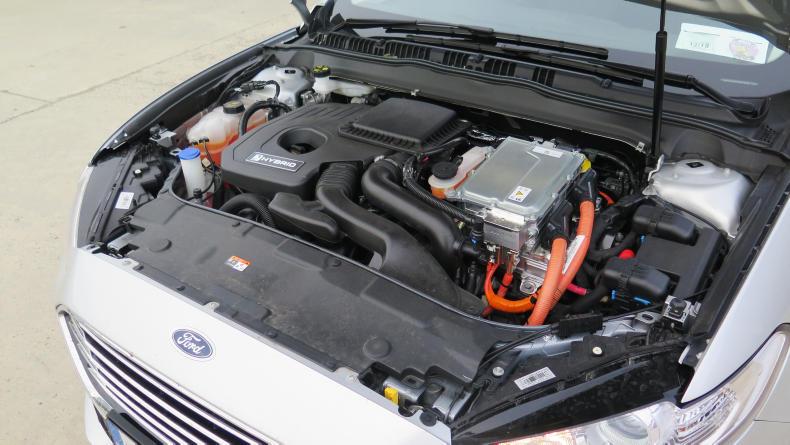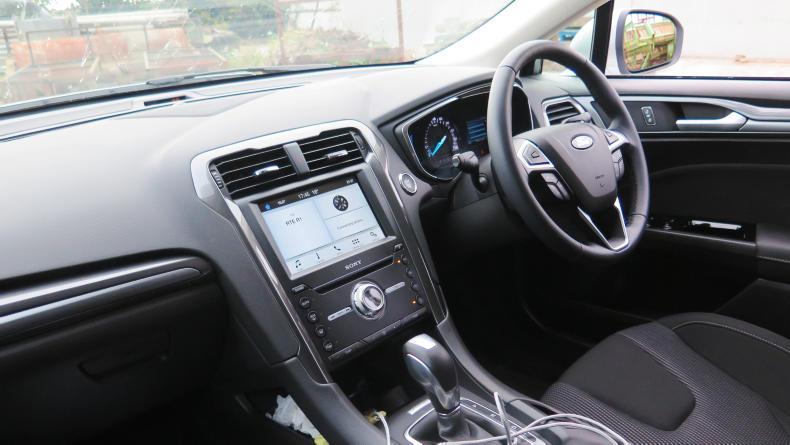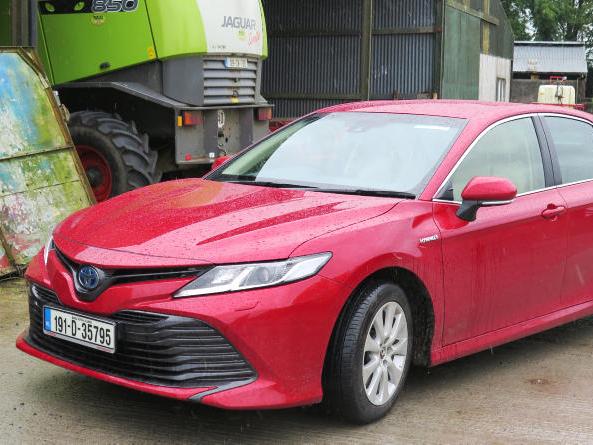Toyota’s Camry, the largest car in the range, made a comeback to the Irish market this year with lots of fanfare. This new generation Camry is a hybrid-only car and it tops all of Toyota’s hybrid and petrol combination drive systems models.
The new generation Camry is big and solid in appearance and it’s Toyota’s best-seller in North America.
The car had a loyal following in Ireland in the past, so will the new Camry attract the old crowd back and win new customers?

The interior styling of the new Toyota Camry is very impressive, with clever design and a luxury feel, layout and materials.
I had the Camry on the road a few weeks ago back in what was an extension of hybrid learning experience, as I had taken Ford’s Mondeo hybrid for a drive around the same time. While both cars are big to begin with, the Camry is probably seen as the bigger of two.
These may not be entirely comparable in many senses, but they are relatively mainstream and from popular brands that have a lot of appeal.
The car did not disappoint in terms of driving comfort and ability
The Camry is the newer of the two and it’s more sophisticated in terms of design and styling.
Toyota has decades of hybrid drive experience now behind it, so the smoothness of the drive from the combination of the 2.5l petrol engine and the self-charging hybrid drive were to be expected.
This is a big car with a big feeling
The car did not disappoint in terms of driving comfort and ability. The petrol engine is rated at 218hp and it delivers powerful acceleration.
This is a big car with a big feeling that can accelerate from standstill to 100km/hr in just 8.3 seconds. That’s fast for a hybrid.
The automatic transmission has six speeds and it is smoothness personified. There are three driving style options and I chose Eco in an effort to get economy, while not wanting to compromise performance too much.

Toyota powers the new Camry with a 2.5l petrol engine combined with a self-charging system that can be economical if driven properly.
I tend to drive a hybrid car with a different level of consciousness compared with a diesel engine car. I set out with economy in mind with the Camry. In a regular week, with lots of rural driving across north Roscommon and into Longford, I returned an impressive range of over 900km on the Camry’s full 50l petrol fuel tank.
I liked the fact that I could drive on the rev counter, so I was careful in terms of higher speed driving when it was not entirely necessary.
It was performing like a diesel car in terms of economy
Keeping the revs close to the 2,000rpm mark made such a difference with the Camry and was the main reason, along with less sporty revving, that gave me this impressive level of fuel economy from such a big car.
It was performing like a diesel car in terms of economy and that was not something I had experienced in a hybrid drive before. A lovely feature of the Camry is that there is power on demand if you need it.

Ford’s Mondeo hybrid is available as a saloon or estate(pictured). The entry prices start from €35,247 or £28,010 in N. Ireland.
The Ford Mondeo HEV model that I drove was the estate version, and is also available as a four-door saloon car.
Ford uses a smaller 2.0l petrol engine in their hybrid, along with a six speed automatic gearbox that’s also smooth, but not quite as smooth as the Toyota offering.
This engine is less powerful than the Camry, despite the cars being almost equal in size (the Mondeo is 14mm shorter in the saloon comparison).
The fact that the Mondeo hybrid is about 150kg heavier than the Camry could account for its poorer acceleration and economy.

Ford uses a smaller 2.0l petrol engine in its Mondeo hybrid, which is less powerful and does not deliver as well as Camry’s economy performance.
The Mondeo comes with a similar size fuel tank at 49l and it was needed. I achieved a range of over 800km from the tank, and that important feature gives the Camry a certain edge.
On paper, the Mondeo was the more economical, while in practice, on runs to Wexford and to the midlands, I found the opposite was true.
The comfort feeling extends to the rear, with great legroom and impressive seats
In styling and specification terms, the new Camry has a more luxury feel to it. The dash layout is beautifully modern and very easy to use. The comfort feeling extends to the rear, with great legroom and impressive seats.
The Camry comes with lots of new safety features, built around the Toyota Safety Sense system. This system provides a suite of driver assistance features that make the car both easy and safe to drive.
The Camry boot space is not compromised by a large battery, as it is in the Mondeo. The Camry boot is large and comes with a spare wheel included.

The dash area of the Ford Mondeo hybrid differs little from the rest of the models in the range with its dark styling.
The battery pack reduced the load space in the Mondeo Estate, so I would expect that in the saloon version, with a luggage area of 383l, it’s even more restricted.
Toyota Camry entry prices start at €39,750 or £30,005 in N. Ireland, while the entry level Mondeo hybrid starts at €35,247 or £28,010 in Northern Ireland.
The specification and driving experience are much different than the price might indicate.
The Camry is so far ahead in terms of driving performance and actual real economy that it is now a diesel challenger, as long as you recognise that you need to slightly modify your driving habits.
The hybrid experience in a car as impressive as the Camry might be well worthwhile, both in terms of driving costs and lifestyle. Maybe that’s why the modern and comfortable Camry has a whole lot more to offer.
Toyota’s Camry, the largest car in the range, made a comeback to the Irish market this year with lots of fanfare. This new generation Camry is a hybrid-only car and it tops all of Toyota’s hybrid and petrol combination drive systems models.
The new generation Camry is big and solid in appearance and it’s Toyota’s best-seller in North America.
The car had a loyal following in Ireland in the past, so will the new Camry attract the old crowd back and win new customers?

The interior styling of the new Toyota Camry is very impressive, with clever design and a luxury feel, layout and materials.
I had the Camry on the road a few weeks ago back in what was an extension of hybrid learning experience, as I had taken Ford’s Mondeo hybrid for a drive around the same time. While both cars are big to begin with, the Camry is probably seen as the bigger of two.
These may not be entirely comparable in many senses, but they are relatively mainstream and from popular brands that have a lot of appeal.
The car did not disappoint in terms of driving comfort and ability
The Camry is the newer of the two and it’s more sophisticated in terms of design and styling.
Toyota has decades of hybrid drive experience now behind it, so the smoothness of the drive from the combination of the 2.5l petrol engine and the self-charging hybrid drive were to be expected.
This is a big car with a big feeling
The car did not disappoint in terms of driving comfort and ability. The petrol engine is rated at 218hp and it delivers powerful acceleration.
This is a big car with a big feeling that can accelerate from standstill to 100km/hr in just 8.3 seconds. That’s fast for a hybrid.
The automatic transmission has six speeds and it is smoothness personified. There are three driving style options and I chose Eco in an effort to get economy, while not wanting to compromise performance too much.

Toyota powers the new Camry with a 2.5l petrol engine combined with a self-charging system that can be economical if driven properly.
I tend to drive a hybrid car with a different level of consciousness compared with a diesel engine car. I set out with economy in mind with the Camry. In a regular week, with lots of rural driving across north Roscommon and into Longford, I returned an impressive range of over 900km on the Camry’s full 50l petrol fuel tank.
I liked the fact that I could drive on the rev counter, so I was careful in terms of higher speed driving when it was not entirely necessary.
It was performing like a diesel car in terms of economy
Keeping the revs close to the 2,000rpm mark made such a difference with the Camry and was the main reason, along with less sporty revving, that gave me this impressive level of fuel economy from such a big car.
It was performing like a diesel car in terms of economy and that was not something I had experienced in a hybrid drive before. A lovely feature of the Camry is that there is power on demand if you need it.

Ford’s Mondeo hybrid is available as a saloon or estate(pictured). The entry prices start from €35,247 or £28,010 in N. Ireland.
The Ford Mondeo HEV model that I drove was the estate version, and is also available as a four-door saloon car.
Ford uses a smaller 2.0l petrol engine in their hybrid, along with a six speed automatic gearbox that’s also smooth, but not quite as smooth as the Toyota offering.
This engine is less powerful than the Camry, despite the cars being almost equal in size (the Mondeo is 14mm shorter in the saloon comparison).
The fact that the Mondeo hybrid is about 150kg heavier than the Camry could account for its poorer acceleration and economy.

Ford uses a smaller 2.0l petrol engine in its Mondeo hybrid, which is less powerful and does not deliver as well as Camry’s economy performance.
The Mondeo comes with a similar size fuel tank at 49l and it was needed. I achieved a range of over 800km from the tank, and that important feature gives the Camry a certain edge.
On paper, the Mondeo was the more economical, while in practice, on runs to Wexford and to the midlands, I found the opposite was true.
The comfort feeling extends to the rear, with great legroom and impressive seats
In styling and specification terms, the new Camry has a more luxury feel to it. The dash layout is beautifully modern and very easy to use. The comfort feeling extends to the rear, with great legroom and impressive seats.
The Camry comes with lots of new safety features, built around the Toyota Safety Sense system. This system provides a suite of driver assistance features that make the car both easy and safe to drive.
The Camry boot space is not compromised by a large battery, as it is in the Mondeo. The Camry boot is large and comes with a spare wheel included.

The dash area of the Ford Mondeo hybrid differs little from the rest of the models in the range with its dark styling.
The battery pack reduced the load space in the Mondeo Estate, so I would expect that in the saloon version, with a luggage area of 383l, it’s even more restricted.
Toyota Camry entry prices start at €39,750 or £30,005 in N. Ireland, while the entry level Mondeo hybrid starts at €35,247 or £28,010 in Northern Ireland.
The specification and driving experience are much different than the price might indicate.
The Camry is so far ahead in terms of driving performance and actual real economy that it is now a diesel challenger, as long as you recognise that you need to slightly modify your driving habits.
The hybrid experience in a car as impressive as the Camry might be well worthwhile, both in terms of driving costs and lifestyle. Maybe that’s why the modern and comfortable Camry has a whole lot more to offer.











 This is a subscriber-only article
This is a subscriber-only article










SHARING OPTIONS: